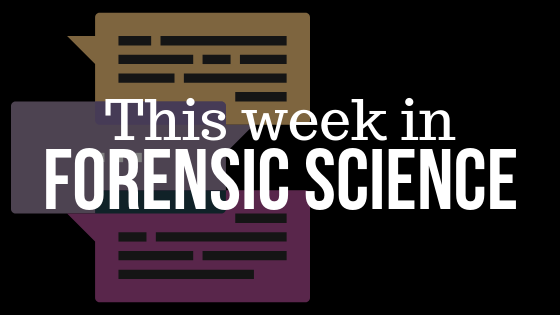No one has hours to scour the papers to keep up with the latest news, so we’ve curated the top news stories in the field of Forensic Science for this week. Here’s what you need to know to get out the door!
DNA Discovery Raises Hopes of Finally Finding Killer of Melanie Hall (The Guardian – 10/4/2019)
Police say they are confident of solving case, 23 years after NHS worker went missing in Bath
Playing Catch a Killer With a Room Full of Sleuths (The New York Times – 10/5/2019)
At a forensic conference in California, law enforcement officials grappled with how to avoid destroying one of the field’s biggest innovations in decades.
DNA Ties California Man to Decades-Old Cold Case Murder, Sexual Assaults: Police (FOX News – 10/6/2019)
- California police say DNA has helped link a 52-year-old man to eight cold cases — the rape and murder of a Fresno woman 23 years ago and the sexual assaults of seven Visalia women between 1999 and 2002.
DNA Technology Solves Decades-Long Unsolved Mystery of Serial Murder in South Korea (ABC News – 10/6/2019)
The killer, Lee Chun-jae, confessed to the murder of 14 victims after detectives extracted DNA from the evidence left at the crime scene using recently developed DNA restoration technology.
Trust Me, I’m an Expert: Forensic Entomology, or What Bugs Can Tell Police About When Someone Died (The Conversation – 10/6/2019)
One of the researchers there is Professor James Wallman, Head of the School of Life Sciences at the University of Technology Sydney, and one of the nation’s few forensic entomologists.
It’s his job to unpack little clues left behind by insects – including the much maligned blowfly – that can help police solve crimes when a body is found.
Perfecting Forensic DNA Mixtures (The Medium – 10/6/2019)
A forensic biologist and a UTM alumna, Dr. Nicole Novroski recently joined the UTM faculty as an assistant professor. Last week, The Medium sat down with her to discuss the journey she undertook after graduating from UTM, her current research on DNA mixtures, and the advice she would give to students who are interested in pursuing a career in forensic science.
Scientists Concerned Over US Plans to Collect DNA Data from Immigrants (Nature – 10/7/2019)
A US government plan to routinely collect DNA data from immigrants in federal custody is sparking concerns among scientists about privacy and discrimination.
Two 1944 Circus Fire Victims’ Bodies Exhumed in Search for DNA (York Dispatch – 10/7/2019)
For 75 years they’ve been numbers in a graveyard — 2109 and 4512 — but on Monday the state medical examiner began the painstaking process of exhuming their bodies in hopes of solving one of the enduring mysteries of the Hartford circus fire.
FBI Confirms Samuel Little’s Confession: He Is the Worst Serial Killer in U.S. History (NBC News – 10/7/2019)
The FBI has verified at least 50 murders connected to Little, outnumbering the crimes of the Green River Killer, Ted Bundy and John Wayne Gacy.
DNA Study Sheds New Light on the People of the Neolithic Battle Axe Culture (Science Daily – 10/9/2019)
Scientists have combined archaeological, genetic and stable isotope data to understand the demographic processes associated with the iconic Battle Axe Culture and its introduction in Scandinavia.
Melbourne University Researchers Leading in Forensics Technology (The Four Point Play – 10/9/2019)
At Monash University in Melbourne Australia, researchers are working with industry professionals to develop technology that will help forensic investigators to track bullet paths in shooting victims. The technology utilizes machine learning and augmented reality, it could fundamentally transform ballistics investigations in Australia and on a global scale.
Responsible Genetic Genealogy (Science – 10/11/2019)
As the custodian of a national law enforcement DNA database (CODIS), the U.S. Federal Bureau of Investigation (FBI) is looked to by many in the law enforcement and forensic DNA communities for guidance, and its efforts often influence the global community. The emergence of FGG suggests that further discussions on privacy, genomics, and the use of genealogy by law enforcement would be beneficial.
WOULD YOU LIKE TO SEE MORE ARTICLES LIKE THIS? SUBSCRIBE TO THE ISHI BLOG BELOW!
SUBSCRIBE NOW!


